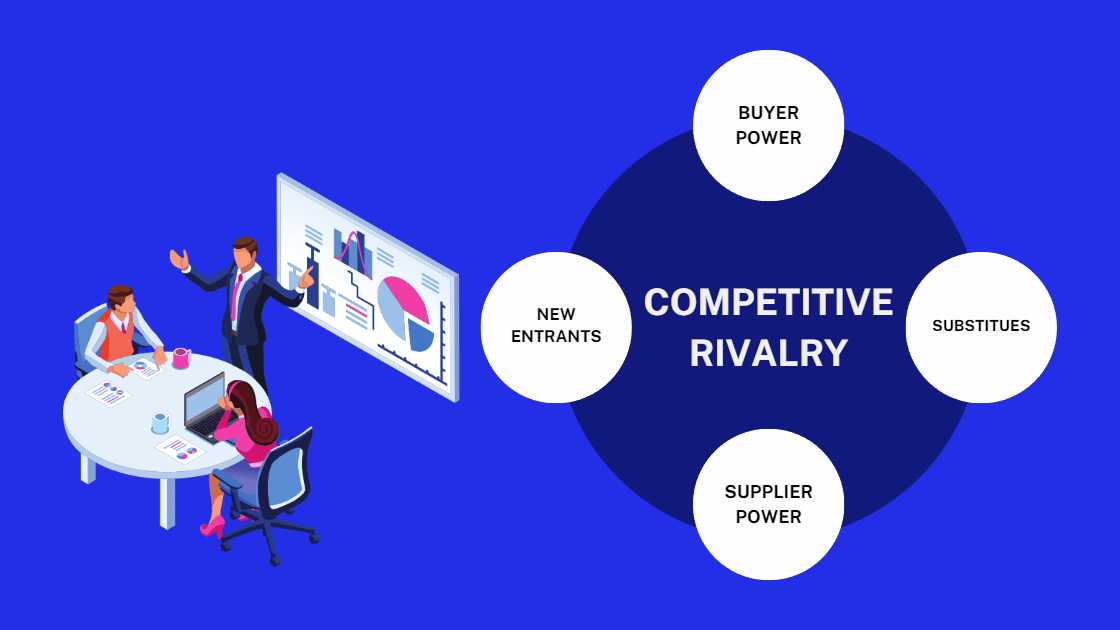Businesses are always looking for an edge in the market, and Porter’s Five Forces Model is one tool that can give them just that.
In this blog post, we will take a deep dive into what this model is, how it works, and how to use it to get a competitive advantage.
Introduction
In 1979, Michael E. Porter of Harvard Business School identified and described five forces that shape every industry and market in the world. These forces are known as Porter’s Five Forces Model. The model is still used today by businesses to understand the attractiveness of an industry and to make strategic decisions.
Porter’s Five Forces Model is a powerful tool for analyzing the competitive dynamics of any industry. It helps to identify potential opportunities and threats in the market, allowing one to make more informed decisions when it comes to business strategy.
What Is Porter’s Five Forces Model?
To understand what Porter’s Five Forces Model is, it is important to first understand what Michael Porter meant when he developed the model.
Porter developed the Five Forces Model to better understand how businesses compete within industries and identify different ways of creating a competitive advantage.
The model looks at five key areas that can affect competition within an industry:
- The threat of new entrants
- The bargaining power of buyers
- The bargaining power of suppliers
- The threat of substitute products or services
- The level of rivalry among existing competitors
- Threat of new entrants: How easy is it for new companies to enter the market and compete? A high barrier to entry makes it more difficult for new firms to get started, protecting incumbent firms from competition.
- Bargaining power of buyers: How much power do customers have to negotiate lower prices or better terms with suppliers? When buyers are strong, they can force companies to compete on price or offer discounts, eating into profits.
- Bargaining power of suppliers: How easy it is for suppliers to increase prices or reduce the quality of their products. When suppliers are powerful, they can put pressure on companies to accept their terms or raise prices, cutting into profits.
- Threat of substitutes: What other products or services are available that can be used in place of what’s being offered? If there are good substitutes, then the market is less attractive. If there are no good substitutes, then the market is more attractive. When there are good substitutes available, companies must work harder to keep customers loyal, which can eat into profits.
- Rivalry among existing competitors: How intense is competition between existing companies in the market? A high levels of rivalry often lead to price wars and other promotional activities that can reduce profits. If competition is high, then the market is less attractive. If competition is low, then the market is more attractive.
Porter’s Five Forces Model helps business owners, strategists, and analysts to better understand the forces that affect competition within an industry.
By understanding these forces, companies can identify opportunities and develop strategies to gain a competitive edge.
Benefits of Using Porter’s Five Forces Model
There are many benefits to using Porter’s Five Forces Model. This model can help you to:
- Understand the competitive forces in your industry and how they affect your business.
- Identify potential new entrants into your market and assess their impact.
- Analyse the bargaining power of buyers and suppliers in your industry.
- Understand the threat of substitute products or services in your market.
- Assess the intensity of rivalry among existing firms in your industry.
- Develop strategies to address these competitive forces and increase your competitive advantage.
- Better forecast market trends in your industry.
- Identify areas of potential growth and investment opportunities in the industry.
Overall, Porter’s Five Forces Model is a useful tool for businesses to better understand the environment in which their business operates. It can help them to make informed decisions about how to stay competitive and profitable in their industry.
Drawbacks of Porter’s Five Forces Model
There are a few potential drawbacks to using Porter’s Five Forces Model.
- It can be difficult to identify all five forces at play in the industry.
- The model does not always consider how changes in one force may impact other forces. For example, a change in supplier power may lead to a change in competitive rivalry.
- The model does not take into account company size or growth potential.
- It can be challenging to accurately assess and measure the strength of each of the five forces. This can make it difficult to create an accurate and comprehensive picture of the competitive landscape.
- The model does not account for changes or shifts in the marketplace over time. This means that it may not be as effective in predicting future industry trends and dynamics.
- The model is based on a number of assumptions about how businesses operate, which may not always hold true in reality.
Overall, Porter’s Five Forces Model is a useful tool for analyzing an industry and understanding its competitive forces, but it is important to understand the potential drawbacks of using it to get the most out of it.
How to Use Porter’s Five Forces Model
Once you understand what each force represents, you can start to identify which forces are most relevant to your business and begin to formulate strategies to address them.
For example,
Differentiate Your Product Offering
If you feel that the threat of new entrants is high, you may want to consider ways to differentiate your product offering or invest in marketing initiatives to build brand awareness and customer loyalty.
Reduce Reliance on Suppliers
If you detect that the bargaining power of suppliers is strong, you may want to explore ways to reduce your reliance on them and identify alternative sources of supply.
Focus on Product Innovation
If the threat of substitutes is high, you may want to focus efforts on product innovation and increasing customer value.
Differentiation from Competition
When analyzing competitive rivalry you will want to assess how competitive the market is and consider ways to differentiate yourself from the competition.
Understanding Buyer Needs
For buyers, it will be important to understand their needs and preferences to incorporate features that appeal to them into your product or service offering.
Porter’s Five Forces Model can be an extremely powerful tool for businesses looking to gain a competitive edge in their industry by understanding their key stakeholders and potential threats in the marketplace.
Example of Porters Five Force Model
A real-life example of Porter’s Five Forces is the airline industry.
- The power of suppliers in the industry is strong because airplane manufacturers have limited competition and can set high prices for their products.
- The power of buyers is also high because they have many viable options when it comes to airlines, and can choose one based on price and services offered.
- The threat of new entrants is low because the airline industry has a large barrier to entry in terms of capital costs, government regulations, and brand loyalty.
- The threat of substitute products is high due to the availability of other transportation options such as trains, buses, and cars.
- Competition among existing competitors is intense due to low margins and intense competition for customers.
Examples of Companies That Have Used the Model Successfully
- Apple Inc.
- Microsoft Corporation
- Amazon.com, Inc.
- Nike, Inc.
Conclusion
Porter’s Five Forces Model is an incredibly useful tool for businesses to gain insight into the competitive landscape of their industry.
With this model, you can identify potential risks and opportunities by analyzing the five forces that influence your business.
By understanding how these forces interact with each other, you will be able to create strategies that will help you stay one step ahead of the competition and maximize your profits.
FAQ
What is Porter’s theory?
Porter’s theory, also known as Porter’s model of competitive advantage, is a framework developed by Michael Porter that helps businesses identify and develop strategies to gain an edge over their competitors.
What is the Porters Five Force model?
Porter’s Five Forces is a model for industry analysis and business strategy development. The model looks at five key forces that shape competition within an industry: supplier power, buyer power, the threat of new entrants, the threat of substitute products, and rivalry among existing competitors.
What is the main objective of the 5 forces model?
The main objective of the Five Forces model is to identify and analyze the competitive forces that have an impact on an industry, helping businesses to understand their competitors and develop strategies for gaining a competitive edge.
What is the importance of Porter’s five forces?
Porter’s Five Forces helps businesses understand the dynamics of their industry and identify areas where they can improve their strategies to gain a stronger position.
What is Porter’s analysis used for?
Porter’s analysis is used to understand the competitive environment within an industry and develop strategies for gaining a competitive advantage. The analysis helps businesses identify the strengths and weaknesses of their competitors and develop strategies to gain an edge over them.
Why is Porter’s five forces better than SWOT?
Porter’s Five Forces looks at the competitive landscape within an industry, while SWOT is limited to just analyzing a company’s internal strengths and weaknesses.




